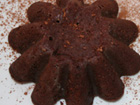Cooking Chicken Breasts Sous Vide -- What is the Best Temperature?
Sous vide is French for "under vacuum". It is a technique where the ingredients are put in a vacuum-sealed plastic pouch, usually for a long time and cooked at a low temperature (usually around 60°C = 140°F). In some cases food is cooked for 24 hours or more, although many excellent dishes can be prepared in under 30 minutes. The technique is currently being used by many of our top chefs including: Thomas Keller, Paul Bocuse, Joël Robuchon, Charlie Trotter, Wylie Dufresne and Heston Blumenthal.
Advantages of Sous Vide Cooking Method
--Food can be seasoned and packed with small amounts of oil, butter or stock that would normally be required in large amounts when poaching foods.
--Low and monitored temperatures can prevent meats from being overcooked
--There is little shrinkage and loss of juices
--There is enhanced nutritional quality; the sous vide technique preserves many nutritional qualities that other cooking methods tend to destroy
Key Temperatures in Cooking Meat and Poultry
COOKING MEAT
120°F/50°C -- Meat develops a white opacity as heat sensitive myosin denatures. Coagulation produces large enough clumps to scatter light. Red meat turns pink.
140°F/60°C -- Red myoglobin begins to denature into tan colored hemichrome. Meat turns from pink to brown-grey color.
140°F/60°C -- Meat suddenly releases lots of juice, shrinks noticeably, and becomes chewy as a result of collagen denaturing.
160°F/70°C -- Connective tissue collagen begins to dissolve to gelatin.
NOTES: At 140°F changes are caused by the denaturing of collagen in the cells. Meat served at this temperature med-rare is changing from juicy to dry. At 160°F/ 70°C connective tissue collagen begins to dissolve to gelatin. This however is a very lengthy process. The fibers are still stiff and dry but meat seems more tender. Source: Harold McGee -- On Food and Cooking
BREAST MEAT IN POULTRY
158°F /70°C -- Breast meat in birds gets dry as collagen contracts and meat gets tougher.
165°F/ 73°C -- Leg meat is full of connective tissue and is chewy if cooked below this temperature.
NOTES: Collagen (fibrous protein constituting a good part of meat) contracts and gets tougher over 70°C/158°F. Thus, the tip is to cook below this temperature to keep the meat tender for breast meat.
Chicken Breast Cooked Sous Vide using the Sous Vide Supreme It appears the best temperature range to cook chicken breasts sous vide is in the 140-147F range. Cooking times will vary depending on the thickness of the breast being cooked and the degree of safety desired. |
In the following procedures: no prior salt was added to the vacuum bag.
Note: In cooking chicken to ensure pasteurization the thickness of the meat was be used to determine the time of cooking.
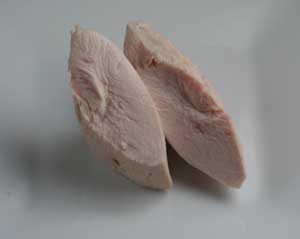 |
137F (Cooking Time -- 120 minutes) Weight of Chicken before -84 grams after 77 grams weight loss = 8.4% cooking time 2 hours Comments: Had excellent flavor with some meaty texture not found at higher temperatures. Retained a lot of moisture. Requires longer cooking times to ensure pasteurization. |
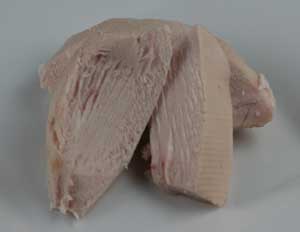 |
140F (Cooking Time -- 90 minutes) 140F is where myoglobin begins to change color, and shrinkage begins. Weight of Chicken: before -82 grams after 74 grams weight loss =9.8 % Chicken now has a pleasant soft white texture. This is the temperature that Heston Blumenthal likes to cook his chicken. Chicken is moist and tender... This may benefit further with short brine. |
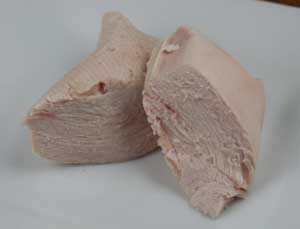 |
147F --(Cooking time 45 minutes) Weight of Chicken: before -84 grams after 74 grams weight loss =11.9 % Still retains sufficient moisture similar to that cooked at 140F. Texture and taste was similar to cooking at 140F.This may benefit further with short brine. |
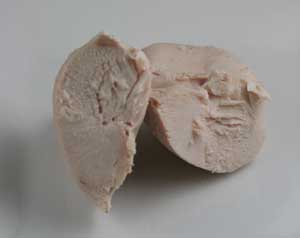 |
160F (Cooking Time -- 45 minutes) Weight of Chicken: before -84 grams after 64 grams weight loss =23.8% This is the recommended temperature since pasteurization occurs very quickly, however meat was very bland tasting, dry with a chewy consistency not found at lower temperatures. |
Conclusions:
Sous Vide chicken appears best cooked between 140-147F. Thicker breasts may be able to retain more moisture... Brining
Safety Issues
See Important Cooking temperatures for more safety information
The rule of thumb among food service professionals is that foods should stay in the so-called "danger zone" (temperature range of 40F to 140F degrees) as briefly as possible since bacteria thrive in that range. However much of sous vide cooking occurs at lower temperatures and even cooking at 140F can be dangerous if one is not familiar with the various D-values for microbes.
D-value refers to decimal reduction time - The time required at a certain temperature to kill 90% (or 1 log10) of the organisms being studied. Thermal inactivation of Salmonella requires a value of 7-D ( 7 log10) and a 12-D reduction is required of C. botulism in canning.
D-values can be depend on pH and salt concentrations as well as fat content in food.
The two tables below give the 7-log10 lethality for Salmonella at two different fat contents. The tables clearly show the extended times required for cooking at low temperatures. Keep in mind these are cooking times required once the thickest portion reaches it's target.
Times for given temperature, fat level, and species needed to obtain 7-log10 lethality of Salmonella*
------------------------------------ fat%=5 ----------------------
| temp F | chicken | turkey |
| 136 | 68.4 min | 65.3 min |
| 140 | 27.5 min | 29 min |
| 145 | 9.2 min | 10.8 min |
| 150 | 2.8 min | 3.7 min |
| 155 | 47.7 sec | 1.2 min |
| 160 | 14.8 sec | 26.1 sec |
Times for given temperature, fat level, and species needed to obtain 7-log10 lethality of Salmonella*
-------------------------------- fat%=12 ------------------------------------
| temp F | chicken | turkey |
| 136 | 81.4 min | 70.8 min |
| 140 | 35 min | 33.7 min |
| 145 | 13 min. | 13.8 min |
| 150 | 4.2 min | 4.9 min |
| 155 | 54.4 sec | 1.3 min |
| 160 | 16.9 sec | 26.9 sec |
For complete list of Tables, see: TIME-TEMPERATURE TABLES FOR COOKING READY-TO-EAT POULTRY PRODUCTS
Salmonella spp. are not particularly heat resistant and most serotypes are killed by normal cooking conditions (see above tables). However, a few highly heat resistant serotypes have been reported.
Because the majority of bacteria that cause food-borne illness are found on the exterior of food, searing meat surfaces before serving will reduce the number of microbes on the surface.
Note: If you have a conduction stove top try using it for low temperature sous vide cooking.
References:
What is Sous Vide Cooking
A Short Guide to Sous-Vide
Time-temperature Tables for Cooking Ready to Eat Poultry
Cooking in a vacuum -- A far cry from boil-in-a-bag, French sous vide technique mesmerizes Bay Area chefs; SFGate, May 2, 2007
Thermal Death Time -- Wikipedia
Salmonella spp. -- Food Safety Authority of Ireland
Food Pathogen Control Data Summary
Tornberg, E. (2005) Effects of heat on meat proteins – Implications on structure and quality of meat products.70: 493–508.
Science of Cooking
See also:
What is the Maillard Reaction?
What are the effects of the Maillard Reaction during cooking?
Health Risks in Cooking
What is the difference between LDL and HDL?
What are the different types of Omega-3 fatty acids?
What is the difference between nitrates and nitrites?
What is the difference between saturated and unsaturated fats?
